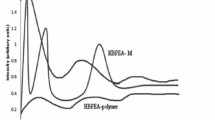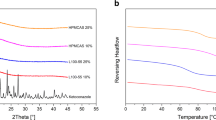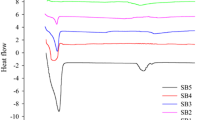Abstract
Organic drugs including aspirin, omeprazole, and naproxen with three different levels of octanol/water partition coefficient were examined for their release behavior from the amphiphilic PCL-b-PEO-b-PCL (PCEC) matrix. Scanning electron micrograph (SEM) of PCEC illustrated a well defined two-phase morphology consisted of dispersed poly(ethylene oxide) (PEO) domain and continuous polycaprolactone (PCL) phase. Differential scanning calorimetry (DSC) and X-ray diffractometry (XRD) experiments verified that three model drugs are dissolved as a molecular dispersion in PCEC matrix. The release of hydrophilic aspirin closely followed the water absorption profile of the matrix indicating that its major fraction is present in PEO domain. However, substantial amount of aspirin present in less hydrophilic region displayed discontinuous biphasic release pattern. In the case of omeprazole with intermediate hydrophobicity consistent release behavior was observed for a period of 24 hrs after the rapid liberation of ca. 10% of the drug presumably partitioned in PEO phase. It was ascribed to the fact that the progressive hydration of PCEC matrix gradually increased the chance of drug/water exposure to compensate the exhaustion of device. Naproxen with the highest octanol/water distribution coefficient among three model drugs exhibited a limited release of 35% for 24 hrs. Finally, hydroxypropyl methylcellulose phthalate (HPMCP)/PCEC blend matrix demonstrated an accelerated and quantitative release of hydrophobic naproxen by generating high porosity and thereby expanding polymer/water interface.
Similar content being viewed by others
References
S. B. Mitra, inPolymers as Biomaterials, S. W. Shalaby, Ed., Plenum Press, New York, 1984, pp 293.
Y. Huang, T. Chung, and T. Tzeng,Int. J. Pharm.,182, 93 (1999).
Y. Hsu, J. D. Gresser, D. J. Trantolo, C. M. Lyons, P. R. J. Gangadhram, and D. L. Wise,J. Control. Rel.,40, 293 (1996).
M. Perez, C. Zunitti, A. Lamprecht, N. Ubrich, A. Astier, M. Hoffman, R. Bodmeier, and P. Maincent,J. Control. Rel.,65, 429 (1999).
F. Delie, M. Berton, E. Allemann, and R. Gurny,Int. J. Pharm.,214, 25 (2001).
C. W. Lee and Y. Kimura,Macromol. Res.,11, 42 (2003).
M. A. Benoit, B. Baras, and J. Gillard,Int. J. Pharm.,184, 73 (1999).
L. Youxin, C. Volland, and T. Kissel,J. Control. Rel.,32, 121 (1994).
W. Lin, D. R. Flanagan, and R. J. Linhardt,Polymer,40, 1731 (1999)
Y. T. Yoo and C. Y. Chung,Polymer(Korea),18, 103 (1994).
W. S. Kim, H. S. Song, B. O. Lee, K. H. Kwon, Y. S. Lim, and M. S. Kim,Macromol. Res.,10, 253 (2002).
I. Molina, S. Li, M. B. Martinez, and M. Vert,Biomaterials,22, 363 (2001).
J. M. Bezemer, R. Radersma, D. W. Grijpma, P. J. Dijkstra, J. Feijen, and C. A. van Blitterswijk, J. Control. Rel.,64, 179 (2000).
A. Boobis, M. Rawlins, S. Thomas, and M. Wilkins, inTherapeutic Drugs, C. Dollery, Ed., Churchill Livingstone Press, London, 1999.
A. L. Iordanskii, M. M. Feldstein, V. S. Markin, J. Hadgragt, and N. A. Plate,Eur. J. Pharm. Biopharm.,49, 287 (2000).
R. H. Muller and K. Peters,Int. J. Pharm.,160, 229 (1998).
P. Le Corre, J. H. Rytting, V. Gajan, F. Chavanne, and R. Le Verge,J. Microencapsul.,14, 243 (1997).
T. Gorner, R. Gref, D. Michenot, F. Sommer, M. N. Tran, and E. Dellacherie,J. Control. Rel.,57, 259 (1999).
T. Higuchi,J. Pharm. Sci.,50, 1145 (1963).
Author information
Authors and Affiliations
Rights and permissions
About this article
Cite this article
Yoo, Y., Shin, HW. & Nam, BG. Effect of Hydrophilic-Lipophilic balance of drugs on their release behavior from amphiphilic matrix. Macromol. Res. 11, 283–290 (2003). https://doi.org/10.1007/BF03218365
Received:
Revised:
Issue Date:
DOI: https://doi.org/10.1007/BF03218365




